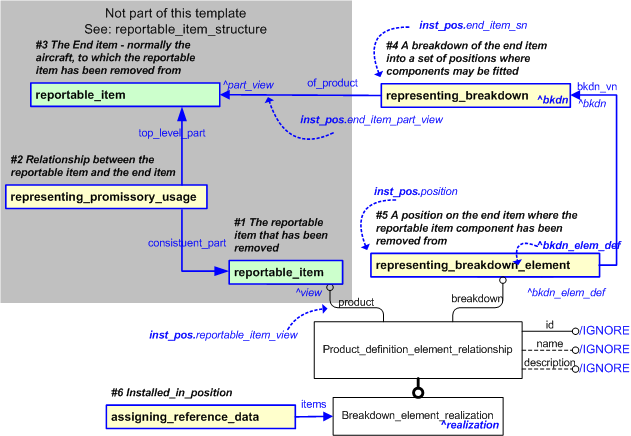
| Template:— installation_position (inst_pos) Context:— MoDAvDEX |
Date: 2008/01/28 11:50:29 Revision: 1.13 |
This section specifies the template installation_position.
NOTE The template has been defined in the context of MoDAvDEX. Refer to the business context for details of related templates.
NOTE An explanation of a template and the associated instantiation path is provided in the Template overview section.
This template describes how to represent the position in which a reportable item is fitted.
See also:
Figure 2 shows the templates required to represent an installation position. The templates shown in yellow in Figure 2 are standard OASIS template. Those shown in light green are business templates developed specifically for the MoDAvDEX context.
Further details of how to represent an installation position using ISO 10303 239 PLCS is provided in Aviation Maintenance DEX: Representing installation/removal position on an aircraft - PLCS representation.
The following templates are shown in Figure 2 and used to represent different aspects of the installation. Figure 2 also shows a number of optional templates which are described in the Characterizations section.
NOTE Template: #1 MoDAvDEX.reportable_item is not instantiated by this template. See MoDAvDEX.reportable_item_structure.
NOTE Template: #2 representing_promissory_usage is not instantiated by this template. See MoDAvDEX.reportable_item_structure.
NOTE Template: #3 MoDAvDEX.reportable_item is not instantiated by this template. See MoDAvDEX.reportable_item_structure.


target
is the parameter to which the
Breakdown_element_realization
is bound.
target
is the parameter to which the
Breakdown
is bound.
target
is the parameter to which the
Breakdown_element_definition
is bound.
| Entity in path | Value | Inherited from |
| Breakdown_element_realization.id | '/IGNORE' | Product_definition_element_relationship.id |
| Breakdown_element_realization.name | '/IGNORE' | Product_definition_element_relationship.name |
| Breakdown_element_realization.description | '/IGNORE' | Product_definition_element_relationship.description |
© UK MOD 2010 — All rights reserved